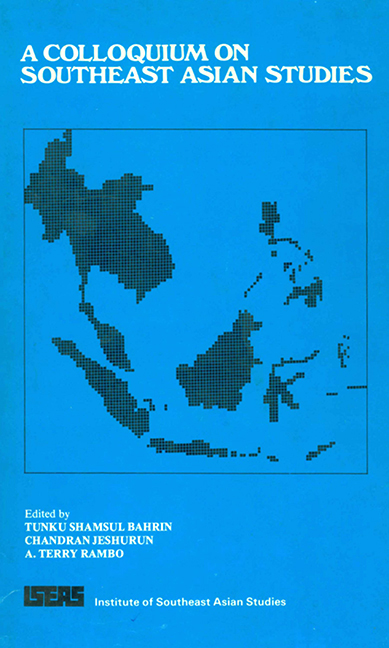Book contents
- Frontmatter
- Contents
- Foreword
- Preface
- Acknowledgements
- Introduction
- Contributors
- PART I TEACHING AND RESEARCH
- THE CONCEPTUAL THEORIES
- THE EXTRAREGIONAL EXPERIENCE
- THE REGIONAL PERSPECTIVE
- 8 Southeast Asian Studies in Indonesia
- 9 Southeast Asian Studies in Malaysia
- 10 Southeast Asian Studies in the Philippines
- 11 Southeast Asian Studies in Singapore
- 12 Southeast Asian Studies in Thailand
- THE PROBLEMS OF TEACHING AND RESEARCH
- PART II ENVIRONMENT AND DEVELOPMENT
9 - Southeast Asian Studies in Malaysia
from THE REGIONAL PERSPECTIVE
Published online by Cambridge University Press: 21 October 2015
- Frontmatter
- Contents
- Foreword
- Preface
- Acknowledgements
- Introduction
- Contributors
- PART I TEACHING AND RESEARCH
- THE CONCEPTUAL THEORIES
- THE EXTRAREGIONAL EXPERIENCE
- THE REGIONAL PERSPECTIVE
- 8 Southeast Asian Studies in Indonesia
- 9 Southeast Asian Studies in Malaysia
- 10 Southeast Asian Studies in the Philippines
- 11 Southeast Asian Studies in Singapore
- 12 Southeast Asian Studies in Thailand
- THE PROBLEMS OF TEACHING AND RESEARCH
- PART II ENVIRONMENT AND DEVELOPMENT
Summary
It might appear an irony of history that universities in Southeast Asia neither led nor followed the rapid development of Southeast Asian Studies programmes which took place in institutions of higher learning outside the region. These latter institutions, on their own momentum, rapidly expanded and extended Southeast Asian Studies after World War II. In contrast, only a handful of indigenous universities either taught or did research in Southeast Asian Studies on any substantial scale even as recently as the early 1970s. Among these institutions were the Asian Center of the University of Philippines, Institute of Asian Studies (Faculty of Political Science, Chulalongkorn University), Institute of Southeast Asian Studies (Singapore), Regional Research Institute (University of Indonesia), Institute of Southeast Asia (Nanyang University), Faculty of Economics (Thammasat University), Faculty of Arts and Social Science (University of Singapore), Southeast Asian Studies Programme (Silliman University) and Faculty of Arts and Social Sciences (University of Malaya).
Background to Southeast Asian Studies Teaching and Research Programme: University of Malaya
The institutionalization of Southeast Asian Studies through the Programme of Southeast Asian Studies at the Faculty of Arts and Social Sciences in the University of Malaya stands as a hallmark in the teaching and researching of the area, not only regionally but also locally. Prior to this time Southeast Asian Studies in Malaysia was dispersed and little effort was made to centralize its teaching and to benefit from the crossing of academic frontiers such as between history and literature and from the pooling of resources such as the bringing together of specialist knowledge and documentary materials on the area. The efficient and effective utilization of existing resources within the university was also a manifestation of the growing sense of regionalism in the country such as is reflected, for example, in the current revised history syllabus for schools.
- Type
- Chapter
- Information
- A Colloquium on Southeast Asian Studies , pp. 98 - 106Publisher: ISEAS–Yusof Ishak InstitutePrint publication year: 1981



